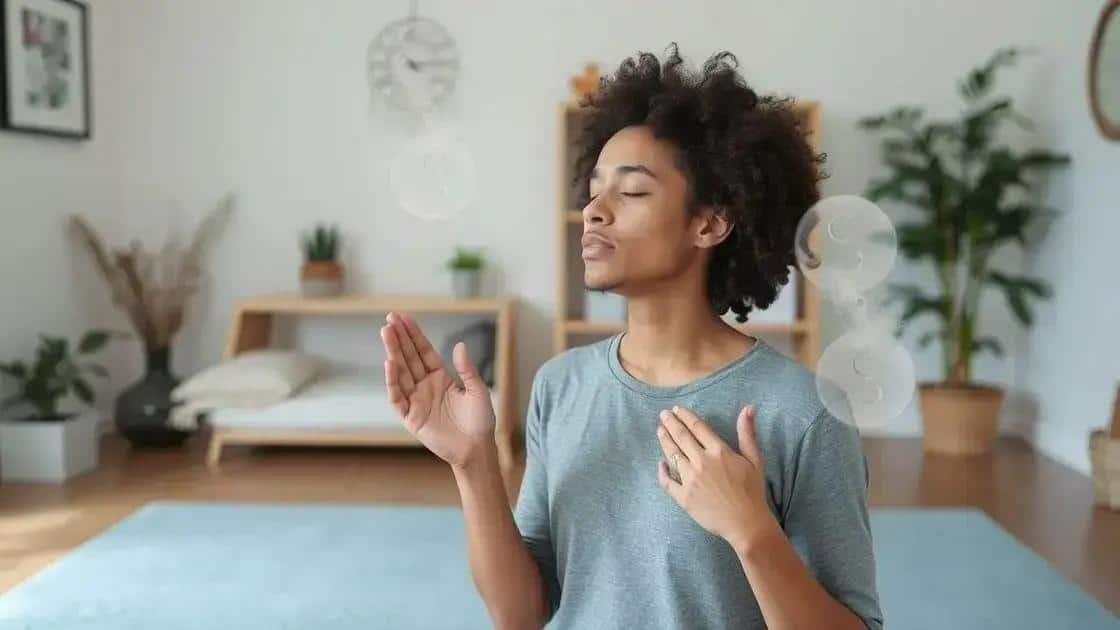Effective breathing techniques for stress relief

Effective breathing techniques for stress relief include methods like diaphragmatic breathing and the 4-7-8 technique, which help reduce anxiety, enhance focus, and promote overall well-being when practiced regularly.
Effective breathing techniques for stress relief might sound simple, but they can significantly change how we handle daily stressors. Have you ever felt overwhelmed and wished you had a quick way to calm down? Let’s explore some practical techniques together.
Understanding the impact of breathing on stress
Understanding how our breathing affects stress is crucial for managing anxiety and improving well-being. When we feel stressed, our breathing often becomes shallow and rapid. However, using effective breathing techniques can help reverse this pattern.
The Stress-Breath Connection
Breathing deeply and slowly sends a signal to our brain to relax. When we take deep breaths, our body releases tension and promotes feelings of calm. This simple act can change how we feel in stressful situations.
Benefits of Deep Breathing
Here are some benefits of practicing deep breathing:
- Reduces feelings of anxiety.
- Improves oxygen flow to the brain.
- Enhances our focus and concentration.
- Helps regulate heart rate.
When we understand these benefits, it becomes clear why effective breathing techniques are essential tools for stress relief. Each deep breath enriches our body, allowing us to respond to life’s challenges more calmly.
It’s also important to recognize that when stressed, many of us hold our breath or breathe poorly, which only worsens our state. By consciously practicing effective breathing techniques, we can transform this automatic response into a method of self-care.
Changing Our Breathing Patterns
We can start changing our breathing patterns in several ways. Here are some techniques to practice:
- Focus on inhaling through the nose for a count of four.
- Hold your breath for a count of four.
- Exhale slowly through the mouth for a count of six.
Practicing these methods regularly can lead to more sustainable stress relief. Over time, you will notice changes not just in your breathing but in your overall sense of peace. Understanding the impact of breathing provides a powerful way to combat stress and improve your quality of life.
Simple breathing exercises to try

Simple breathing exercises are an excellent way to manage stress effectively. By incorporating a few easy techniques into your daily routine, you can promote relaxation and enhance your well-being. These exercises are practical and can be done anywhere, making them accessible tools for everyone.
1. Diaphragmatic Breathing
This technique focuses on deep belly breathing, which helps increase oxygen intake. To practice:
- Find a comfortable position, either sitting or lying down.
- Place one hand on your chest and the other on your abdomen.
- Breathe in through your nose, ensuring your belly rises while your chest remains still.
- Exhale slowly through your mouth.
By focusing on your abdomen, you engage the diaphragm and allow for more efficient breathing. This method can be particularly calming during moments of anxiety.
2. 4-7-8 Breathing Technique
Another effective exercise is the 4-7-8 technique. This method combines counting with your breath to foster relaxation:
- Breathe in deeply through your nose for a count of 4.
- Hold your breath for a count of 7.
- Exhale slowly through your mouth for a count of 8.
This rhythm creates a soothing experience that can help ease tension. Repeating this cycle four times can significantly lower stress levels.
Incorporating these simple breathing exercises into your routine can offer immense benefits. You can practice them during your break at work, while commuting, or even at home before bed. The key is to be mindful of your breathing and remain patient with yourself as you learn.
3. Box Breathing
Box breathing is a structured technique that enhances focus and calms the mind. Here’s how to do it:
- Breathe in for a count of 4.
- Hold for a count of 4.
- Exhale for a count of 4.
- Hold again for a count of 4.
This method is especially useful in high-pressure situations, as it helps reset your stress response.
By consistently practicing these simple breathing exercises, you can improve your overall mental health and develop better responses to stress. Remember that the journey to stress management is gradual, and every little effort counts.
Integrating breathing techniques into daily life
Integrating breathing techniques into daily life can transform how we respond to stress. By making these practices part of your routine, you can build resilience and enhance your overall well-being. It’s easier than it sounds, and small adjustments can lead to big benefits.
Start with Small Moments
One effective way to incorporate breathing techniques is to begin with small moments throughout your day. For example, while waiting in line or during a break, take a moment to practice a few deep breaths. This simple action can reset your mind and body.
Breathing Exercises in the Morning
Begin your day with a specific breathing exercise. Spend just five minutes each morning focusing on your breath. You can try:
- Sitting in a comfortable position.
- Taking deep breaths in through your nose and out through your mouth.
- Using a count to guide your breathing, like inhaling for four counts and exhaling for six.
This practice sets a positive tone for the day and prepares you to face challenges with a clearer mind.
You can also integrate breathing techniques into routine activities. For instance, focus on your breath while commuting or exercising. Being present with your breath keeps you grounded and aware, which is beneficial for managing stress.
Mindful Breathing During Stressful Moments
When you encounter a stressful moment, practice mindful breathing to regain control. Take a break and follow these steps:
- Inhale deeply while counting to three.
- Hold your breath for a moment.
- Exhale slowly, allowing your shoulders to drop.
Doing this can calm your nervous system and help you approach the situation with a level head. Repeating this process multiple times can create a significant shift in how you feel.
Remember that consistency is key. The more you practice, the more natural it becomes to use breathing techniques in daily life. These methods are powerful tools that enhance your ability to manage stress effectively, contributing to a healthier mindset.
Long-term benefits of effective breathing practices

Long-term benefits of effective breathing practices can significantly enhance your mental and physical health. By incorporating these techniques into your daily routine, you can experience lasting improvements in stress management, focus, and overall well-being. These benefits extend beyond simple relaxation; they promote a healthier lifestyle.
Improved Anxiety Management
One of the most notable benefits is the reduction of anxiety levels. Regular practice helps train the body to respond more calmly to stressors. As you consistently engage in effective breathing techniques, you become more adept at managing anxious feelings. This skill can make a considerable difference in high-pressure situations.
Enhanced Focus and Concentration
Breathing exercises can also boost your ability to concentrate. By taking moments to focus on your breath, you clear your mind and enhance your mental clarity. Over time, this practice can lead to better performance in daily tasks. You may notice:
- Improved attention during work or study.
- Increased productivity.
- Enhanced creativity and problem-solving skills.
These benefits contribute to a more fulfilling life, enabling you to tackle challenges with a clearer mindset.
Physical Health Benefits
In addition to mental benefits, effective breathing practices can enhance your physical health. By ensuring proper breath control, you improve oxygen flow throughout your body, which supports various bodily functions. Regular practice can lead to:
- Lower blood pressure.
- Improved lung capacity.
- Better circulation.
As your body receives more oxygen, it can function more efficiently, leading to increased energy levels and vitality.
Committing to effective breathing practices can ultimately reshape your lifestyle. The power of intentional breathing should not be underestimated. By investing time in these simple yet profound techniques, you cultivate a healthier mind and body, paving the way for a more vibrant future.
FAQ – Frequently Asked Questions about Effective Breathing Techniques for Stress Relief
What are effective breathing techniques?
Effective breathing techniques are methods that help control your breath to improve relaxation, reduce stress, and enhance mental clarity.
How can I integrate these techniques into daily life?
You can practice these techniques during everyday moments, such as while commuting, during breaks, or in the morning to start your day calmly.
What benefits can I expect from regular practice?
Regular practice can lead to reduced anxiety, improved focus, better health, and greater emotional balance.
Are these techniques suitable for everyone?
Yes, breathing techniques are suitable for people of all ages and can be adapted to fit individual needs and lifestyles.





